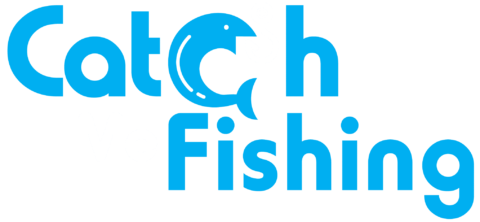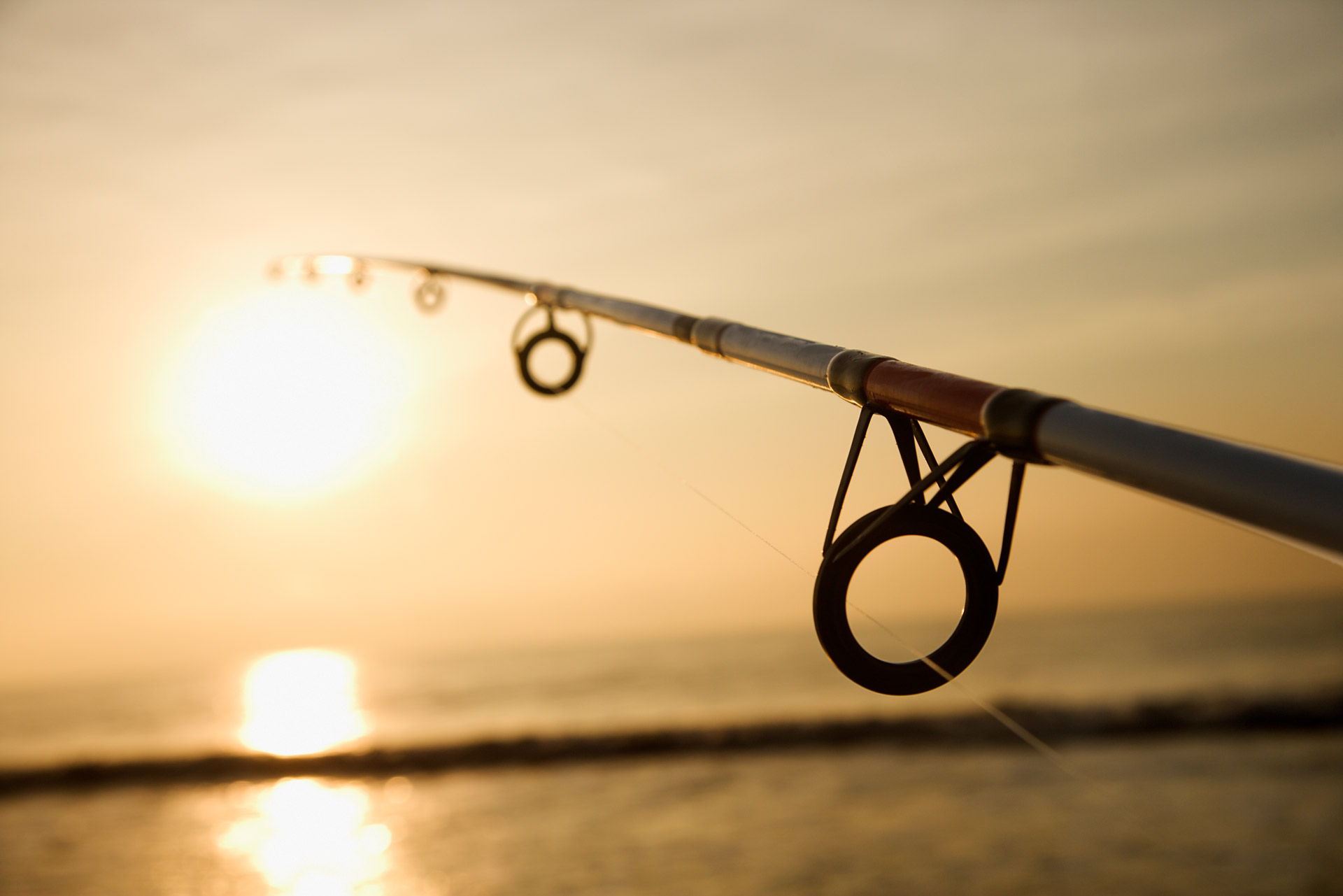What is Fly Fishing? 7 Basic Fly Fishing Steps For Beginners
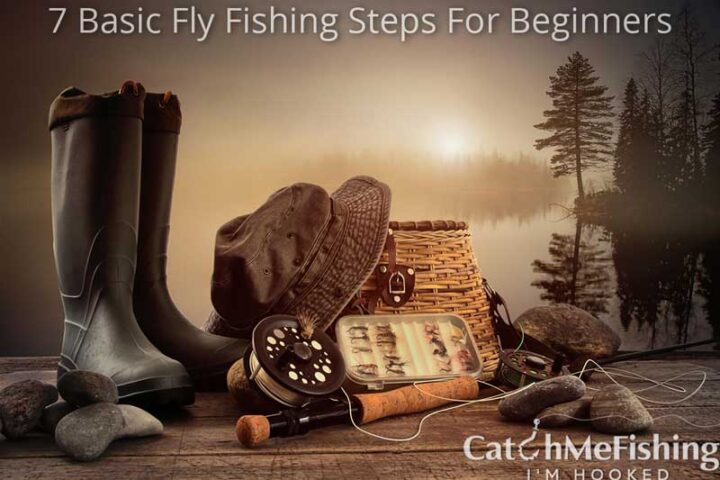
What is fly fishing? In what is the simplest form of angling, the hard part is just getting going.
If you’re wondering how does fly fishing work? don’t let the bewildering jargon – seven-weights, Woolly Buggers, tippets or tight loops – put you off. Work through this guide step by step and you’ll know everything you need to get on the water and in the game.
Everything else you can learn as you go along…
What is fly fishing? - 7 Basic fly fishing steps to get you started
- Step 1 – What gear do I need?
- Step 2 – So many flies, so little time
- Step 3 – Casting coach
- Step 4 – Should my fly be doing something?
- Step 5 – Fishing rivers
- Step 6 – Fishing lakes
- Step 7 – I’ve hooked my first trout; now what?
- Recommended Gear
WHAT GEAR DO I NEED?
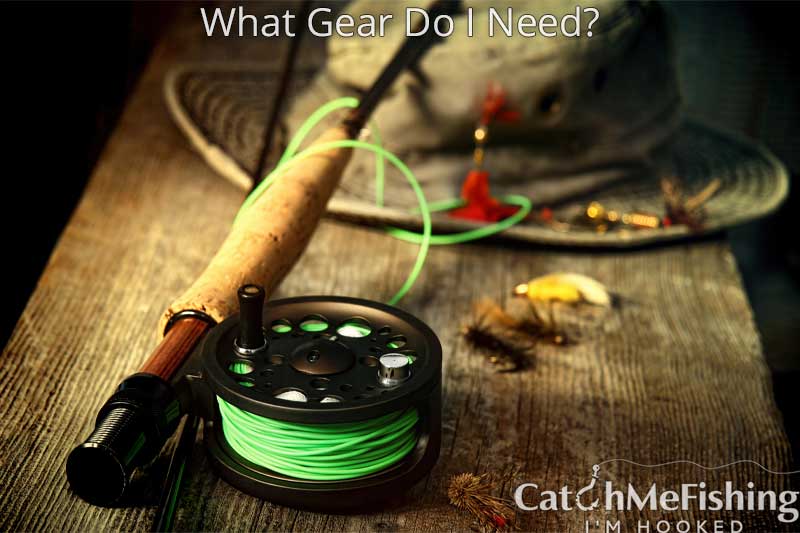
Rod
Fly rods come in a range of lengths and weights and in time you’ll own several. For the newbie, however, a 9ft 6- or 7-weight rod (the weighting will be marked on the rod as “6wt”, “7wt”, or “#6”, “#7”) keeps your options open – it has enough casting power for lakes but is also suitable for rivers, while its relative stiffness will help a novice get a hooked fish to the net quickly (weary, over-played fish struggle to recover when released).
Evolving rod-making technology has narrowed the gap between the best and worst rods, so you’ll now find a decent fly rod for around £100.
Rod pick - Greys GR20 Fly Rods (9ft #7): Amazon.co.uk: Sports & Outdoors
Reel
A fly reel is essentially just a line container but it must still tick certain boxes:
- Durable – accidentally drop your rod, and the reel will be the first thing to hit the ground.
- Balanced – with a balanced rod and reel, you barely know the reel’s there when you’re casting. If you’re all too conscious of it, on the other hand, your casting arm will soon tire.
- Depth – it must have sufficient capacity for your fly line and around 75 yards of backing line (see below).
- Mid- or large-arbour – arbour size refers to the width of the reel’s ‘base’; the core around which you wrap fly line and backing line as you fill the reel. Mid- or large-arbour reels have a broader base than the standard arbour, so you retrieve more line with each turn of the reel handle. They also allow line to be stored on the reel in wider coils, making it less susceptible to ‘memory’.
- Easily dismantled - grit plays havoc with a reel, so you must be able to clean it thoroughly.
- Brakes – they stop hooked fish from stripping line from the reel too quickly, triggering tangles. An adjustable drag system is the ideal; a ratchet or click-and-pawl the bare minimum.
Our reel choice - Orvis Clearwater Large Arbor Cassette: Amazon.co.uk: Sports & Outdoors
Backing line
Big, headstrong fish must be allowed to run when hooked, to tire them and spare you a snapped rod, but your fly line may not be long enough for this on its own. Hence the need for a length of backing line between reel and fly line.
Great backing line - Airflo MICRO POLY BACKINGORANGE 20LB 500M: Amazon.co.uk: Sports & Outdoors
Fly line
A 6- or 7-weight WF floating line will match the weighting of the rod recommended earlier. Floating lines, which lie on top of the water, are easier to cast than heavier sinking lines, while the ‘WF’ means ‘weight-forward’ – the line’s weight is concentrated at its leading end, helping you cast further.
Fly Line - Rio Products Fly Line Avid Trout Wf7F Pale Yellow, WF7F/90ft: Amazon.co.uk: Sports & Outdoors
Leader
Having thick fly line immediately next to your fly would scare off most fish, so fly line and fly are connected by a section of much finer leader line. Start with a 9ft leader length (anything longer is likely to tangle when you’re getting used to casting) and use monofilament nylon leader (commonly known as “mono”) to start with. Fluorocarbon leader is less visible in the water but it’s pricy.
Leader must combine slenderness with sufficient strength for the size of fish you’ll encounter. Breaking strain of 5lb to 8lb should be enough for trout but do look at different brands, as some makes of leader can be finer than others while having an identical breaking strain.
When your casting improves, a short section of ultra-fine line, or ‘tippet’, connecting the leader to the fly can help where trout are particularly wary.
You can knot leader directly to the fly line but a braided leader loop is more convenient.
Leader - snowbee monofilament fly leaders 8lb: Amazon.co.uk: Sports & Outdoors
Accessories
Landing net – it must be big enough for the size of fish you’re likely to encounter and go for a net with modern rubber mesh, which doesn’t damage fish like the abrasive, knotted cord mesh of yesteryear. If boat fishing, you need a long-handled net which floats. The long handle lets you net fish at range before the proximity of the boat panics them.
Sunglasses – never fish without them: if the wind gets up while you’re casting sharp hooks, you’re playing Russian roulette with your eyes. Plus, a good pair of polarised lenses lets you see so much better what’s happening below the water’s surface.
Nippers – tempting as it is to trim leader with your teeth, you’re flirting with a dental nightmare. Nail clippers are ideal.
Floatant/Sinkant – you can buy substances designed to keep dry flies afloat and your leader sunk into the water’s surface film (where it’s not so obvious to fish).
Priest – a small club with which you kill fish intended for the table.
Clothing
A hat protects your head from badly cast hooks. While there’s a strong trend towards baseball caps, a wide-brimmed fedora will protect all sides of your head from the sun.
Waterproof jacket, trousers and footwear are essential but seek advice from experienced anglers before buying. Manufacturers have varying perceptions of the word ‘waterproof’…
Whatever you wear, stick to natural colours; greens, browns and blacks. Loud colours can scare fish.
Baggage
A holdall or specialist fishing bag will suffice for the fly fishing beginner but consider a fishing tackle box in heavy-duty plastic if you plan to go boat fishing. It keeps out not only the rain but also the water that invariably pools in the bottom of a boat.
Permits
No matter how wild or remote that lake or stream you have in mind might be, you should always make careful enquiries as to whether a permit is required. If there is no local fly fishing club to contact, ask at the nearest fishing tackle shop or on an internet forum.
If fishing in England & Wales, you will need a trout fishing licence. Different procedures apply in Scotland, Northern Ireland and the United states.
SO MANY FLIES, SO LITTLE TIME
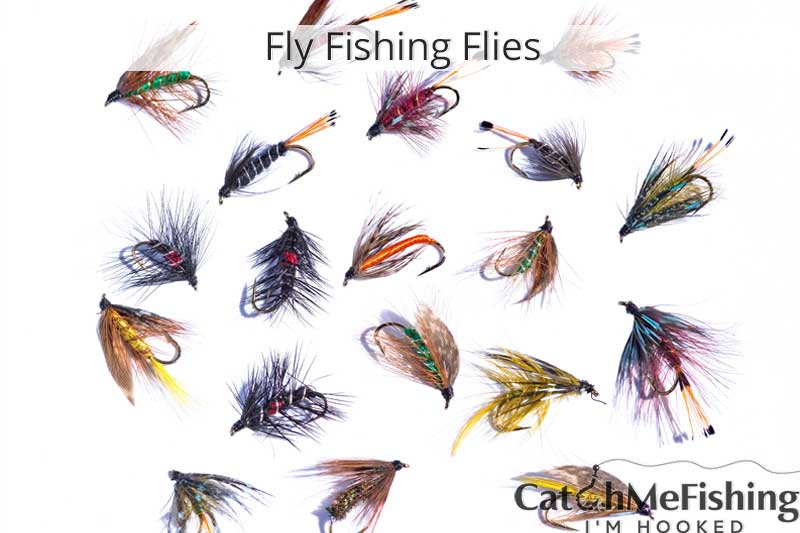
Imitation fly patterns are out there in their hundreds but trout fishing for beginners needs only a handful of them. Sometimes it’s not the fly but its size that tempts trout, so look for small and large versions of the following patterns when fly shopping. And if you intend to release any fish you catch, you need flies with barbless hooks, which can be easily removed from the fish’s mouth.
Dry flies (fished on the surface)
Parachute Adams – while it’s great if your fly resembles a specific bug, it can be effective just by resembling food generally. This pattern suggests several types of dark-bodied insects.
F Fly – a pale-bodied version is ideal for imitating lighter-coloured insects.
Chernobyl Ant – this foam-bodied monstrosity comes into play when the wind is depositing terrestrial insects onto the water.
Sub-surface flies
Pheasant-tail Nymph – another generic imitation, it could pass for a wide range of immature insects about to hatch at the surface.
Hare’s Ear – this nymph all-rounder works in all conditions, the tawny hare’s fur reminding fish of various insect larvae or crustaceans.
Woolly Bugger – this lure catches fish in lakes or rivers.
Muddler Minnow – another lure and a general attractor pattern that puts fish in mind of anything from sedges to grasshoppers.
CASTING COACH
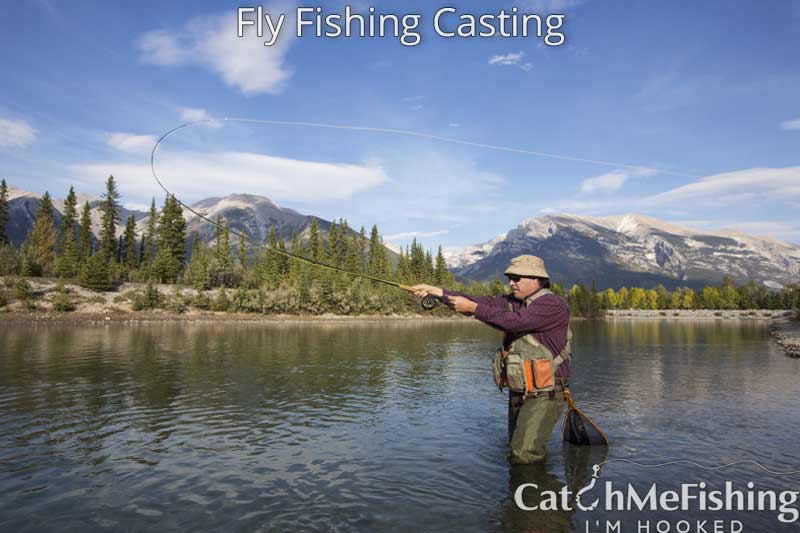
Of all the fly fishing tips for beginners, this one is golden: invest in a casting lesson with a qualified instructor before your first day’s fishing. The good ones make book- or video-learning distinctly second-best.
While you’re trying to absorb everything he/she teaches you, focus on these key thoughts…
- The essence of casting is rhythm, not power. The fly line must unfurl fully behind you on your back cast before you start the forward cast, or the cast will lose both rhythm and momentum.
- The line should unfurl while still parallel to the ground. If it’s falling towards the ground while unfurling, then your casting stroke needs a little more power.
- Open your stance so that you can comfortably observe the back cast over your shoulder. Being able to watch back cast and forward cast alike will give you a much better feel for casting’s tempo.
The definitive book on casting describes more than 20 types of cast but you’ll be fine with just three – the basic overhead cast, the sidearm cast (when you need to cast a low line beneath overhanging branches) and the roll cast, for when a lack of space behind you rules out an overhead cast.
SHOULD MY FLY BE DOING SOMETHING?
Sometimes, you just cast and wait. More often, though, you must put some movement into your fly to ‘sell’ it to a fish.
Continuous retrieve
The figure-of-eight retrieve is employed with lures or traditional wet flies. It keeps your fly in constant motion as you draw it back towards you. Sometimes, the retrieve will have to be brisk to persuade a fish to take the fly; at other times (like winter, when trout are lethargic as their metabolism slows) only slow-moving flies will appeal to them.
With nymphs, you retrieve very gently, just enough to keep your fly at the right depth.
On the drop
Trout are used to seeing natural nymphs move up and down through the water column, so as an alternative to holding your artificial nymph at the same depth, just let gravity take its course when you cast it: fish will occasionally take it while it’s dropping through the water.
Static retrieve
This contradiction in terms is how you fish dry flies – by simply doing nothing as they bob on the surface. If there’s no response, give the fly an occasional twitch to alert fish to its presence.
FISHING RIVERS
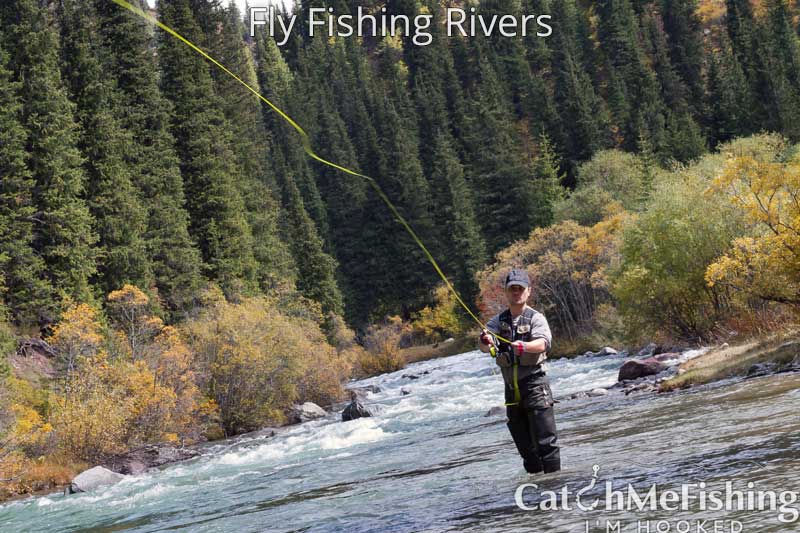
The watercraft that will eventually enable you to read a river like it’s an open book will be some years in the making but these general tips will get you started:
- Trout are drawn to places where they find food and shelter. They will often sit just downstream of boulders, where they rest out of the current and feed on passing bugs. Undercut banks and fallen trees, meanwhile, offer them overhead cover.
- Lines of foam moving downstream reveal food-bearing current ‘lanes’ into which you should cast your fly.
- You’ll rarely see whole fish when you look at a river. Train yourself to be alert to unusual shadows or brief flashes of colour instead, which can indicate fish.
- Big fish can swim in low water, so don’t immediately write off shallow stretches.
Related - How To Read a River Perfectly
FISHING LAKES
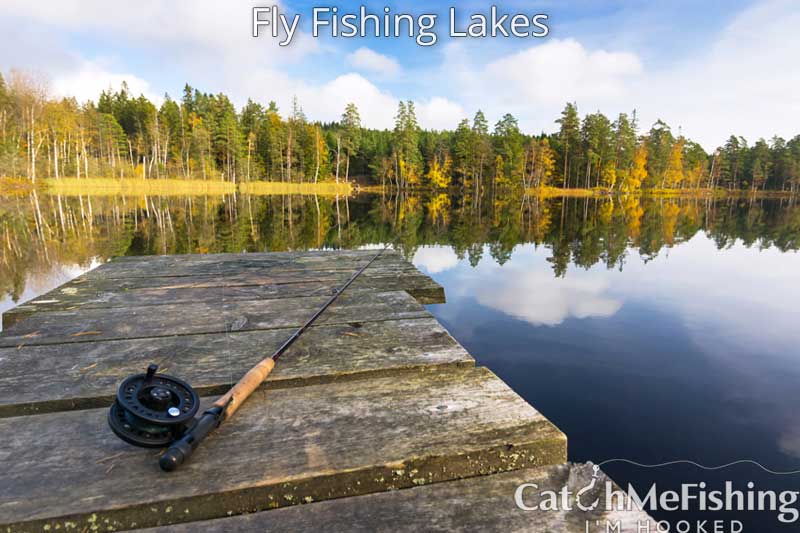
Currents and underwater terrain aren’t the factors in deep lakes that they are in rivers, so your focus has to shift.
- You’re looking more at what’s above the water now. Fish are drawn to ‘structure’, the collective term for features like spurs of land extending into the lake, a jetty or partially sunken fence.
- If you can observe the lake from an elevated position, look for patches where the water abruptly darkens: it could indicate a ledge or drop-off beneath the surface, and that’s a prime hang-out for trout, which shelter in the deep water, occasionally darting into the adjacent shallows for food.
- If the wind is blowing towards a particular shore it will be pushing food in the same direction, and fish will follow. To catch them from that shore, though, raises a thorny question — how do you fly fish into the teeth of a gale? There are ways of casting into a headwind but it needs practice.
- Birds flying low over the water may well be attacking newly-hatched insects. If so, trout will be congregating in the same area, for the same purpose.
- Trees or other vegetation near the water’s edge house insects that will be blown onto the water when the wind gets up. Trout get wise to this.
- If in the absence of rising fish, identifying how deep in the water they are lying is crucial. Fish nymphs or streamers at varying depths until you find the correct ‘seam’.
I’VE HOOKED MY FIRST TROUT, NOW WHAT?
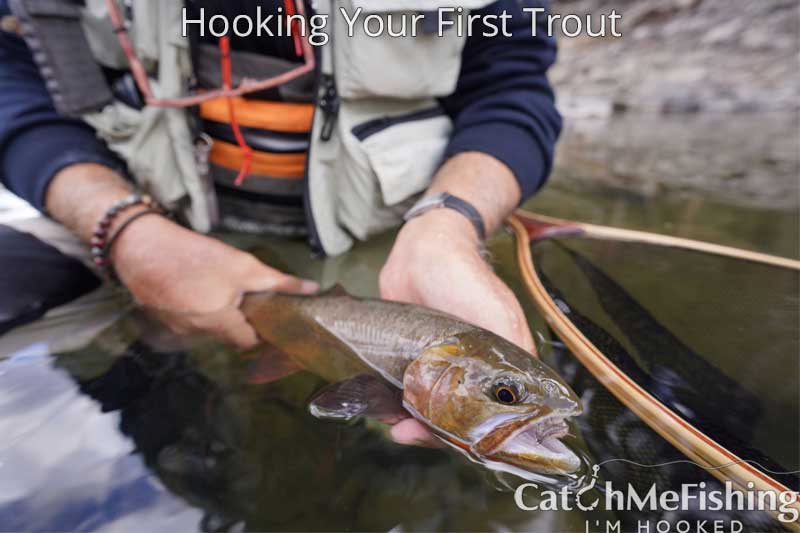
The take
It’s not unheard of for fish to take an artificial fly as soon as it hits the water, so you must be on your toes the second you finish casting.
Some takes will be unmistakable; others less so. Anything unusual in the movement of a fly being retrieved could indicate a hooked fish, such as your line suddenly moving sideways or decelerating.
Keep your rod tip close to the water when retrieving, so that you immediately feel any takes transmitted through the line.
Be ready to strike right up to the moment when your fly is about to exit the water at the end of the retrieve. At that point, it looks like an insect that’s about to fly off and trout will often grab it rather than miss out.
The strike
If you feel a trout has taken the fly, sharply raise your rod tip just a few inches to secure the hook in the fish’s mouth.
The fight
When you’re satisfied that the hook is engaged, your priority is to raise your rod tip to around a 45-degree angle, while your rod hand traps the line against the rod. At that angle, the rod and not just your leader is taking the strain of the fish, but you must keep the rod tip high, to keep tension in the line. Trout often wriggle free from a hook when the line goes slack.
When the fish wants to run, release line gradually through your rod hand to reduce pressure on the rod.
Such runs usually alternate with pauses, at which point you retrieve line with your free hand until the fish decides to run again. Take advantage of those pauses to try and get some of the retrieved line back onto the reel, as that reduces the chance of your feet getting tangled with line on the ground in the excitement of the moment.
The catch
You’re almost there once your fish is splashing pathetically on the surface, but a glimpse of your net will reignite its escape instinct, so keep the net just under the surface when you’re ready to land the fish.
Don’t move your net towards the fish but use your rod to bring the fish to your net. When the trout rolls onto its side, guide it over the net and lift the latter so that the fish drops in. If you’re returning the fish, lower the net back into the water just enough to let you unhook and release the fish without removing it from the water. If touching the fish is unavoidable, wet your hands first, as dry hands damage the trout’s slimy ‘coat' which protects it against infection. If you’re keeping it for the pot, on the other hand, relocate the net to the bank, wrap the fish in the mesh to control it, and strike one or two sharp blows to the back of its head with your priest.
Recommended fly fishing gear to get you started:
Rod - Greys GR20 Fly Rods (9ft #7): Amazon.co.uk: Sports & Outdoors
Reel - Orvis Clearwater Large Arbor Cassette: Amazon.co.uk: Sports & Outdoors
Backing line - Airflo MICRO POLY BACKING ORANGE 20LB 500M: Amazon.co.uk: Sports & Outdoors
Fly Line - Rio Products Fly Line Avid Trout Wf7F Pale Yellow, WF7F/90ft: Amazon.co.uk: Sports & Outdoors
Leader - snowbee monofilament fly leaders 8lb: Amazon.co.uk: Sports & Outdoors
Landing net - Snowbee Boat And Bank Landing Net - Silver/Green, One Size: Amazon.co.uk: Sports & Outdoors
Sunglasses - Wychwood Black Wrap Sunglasses Brown Lense: Amazon.co.uk: Sports & Outdoors
Nippers - Orvis Comfy Grip Nippers, Storm Grey: Amazon.co.uk: Sports & Outdoors
Floatant - Loon Outdoors - Lochsa Dry Floatant: Amazon.co.uk: Sports & Outdoors
Sinkant - Fullers Earth Fine Powder 250g - Pure & Natural Calcium Bentonite: Amazon.co.uk: Beauty
Priest - Wooden Priest Trout Fishing Tackle Accessory Priest with lanyard: Amazon.co.uk: Sports & Outdoors
Waterproof jacket - Paramo Men's Helki Waterproof Breathable Jacket: Amazon.co.uk: Clothing
Waterproof trousers - Paramo Men's Cascada II Waterproof Breathable Trousers: Amazon.co.uk: Clothing
Waterproof boots - Dunlop Purofort Rigair Full Safety Fur Lined Rigger Boots: Amazon.co.uk: Business, Industry & Science
Bag - Shakespeare Sigma Game Bag - Green: Amazon.co.uk: Sports & Outdoors
Plastic tackle box - Plano 136200 2-BY Rack System 3600 StowAway Tackle Box: Amazon.co.uk: Sports & Outdoors
Flies
Parachute Adams - 6 Pack of Adams Parachute Trout Flies Choice (14/16): Amazon.co.uk: Sports & Outdoors
F Fly - TroutfliesUK Barbless CDC F Fly, 6 x Hares Ear F Fly
Chernobyl Ant - Chubby Chernobyl Ant Golden Foam Body Trout Fly Fishing Flies - 4 Flies - Hook Size 10 - Trout and Bass Flies: Amazon.co.uk: Sports & Outdoors
Pheasant Tail Nymph - Weighted Pheasant Tail Nymph Trout Fly, 6 Pack weighted Body, Choice of sizes, Fly Fishing: Amazon.co.uk: Sports & Outdoors
Hare’s Ear - 6 Pack Barbless Hares Ear Nymph, Trout Flies, Choice of Sizes, For Fly Fishing: Amazon.co.uk: Sports & Outdoors
Woolly Bugger - Woolly Bugger Trout Flies, 6 Pack, Black size 10, For Fly Fishing, Lures: Amazon.co.uk: Sports & Outdoors
Muddler Minnow - Muddler Trout Flies, 6 Pack Natural Muddler Minnow, Choice of Sizes, Fly Fishing: Amazon.co.uk: Sports & Outdoors]


